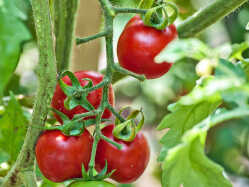Common tomato problems and how to deal with them

No one enjoys dutifully tending to their garden all growing season and ultimately ending up with a poor tomato crop. Sadly, tomatoes can fall victim to a number of diseases and fungi that can impact the plant or the fruit itself. Additionally, there are a number of insects that can damage your tomato plants.
Typically, the number-one issue related to the fruit of the tomato plant deals with tomatoes that have sunken-in, scarred bottoms. This problem is blossom-end tot. Blossom-end rot is a dry, black, leathery scar on the blossom-end of the fruit brought on by a calcium deficiency. To prevent this, try to ensure your plant always has proper moisture.
Other common issues that impact the fruit are fruit cracks, sun scald and catfacing.
Fruit cracks will usually occur during hot, rainy periods when the fruits are exposed to the sun. Although the fruit does not look appealing, it can still be utilized.
Sun scald is when the fruit will first develop a yellow or white patch that will later blister and dry. This occurs when there is poor foliage cover resulting in the fruit being exposed to sun. This often happens when the tomato plant has been pruned, staked improperly or you have sprawling plants. The best prevention for sun scald is to cage your plants when possible.
Catfacing is the puckering and scarring at the blossom end of the fruit. The cavities created by catfacing may penetrate deep into the fruit, making it impossible to eat. This is often caused by cool, cloudy weather when the plant is blooming or when some herbicides are used.
When it comes to insects impacting your tomatoes, the biggest culprit is the tomato hornworm. Tomato hornworms are green and white worms that are known for their protruding “horn.” They can be up to four inches long and are known for destroying the foliage of tomato plants and eating the green fruit. Please note that tomato hornworms are known to also feed on peppers, eggplants and potatoes. The best solution for a gardener is to take time and hand-pick any tomato hornworms from their plants. Once removed, you can squish them, drop them in water or dispose of them in your preferred method.
This year, I have also had several clients contact with issues of nuisance wildlife impacting their tomato crop. The culprits appear to be birds and groundhogs. As you can imagine, birds will peck into the tomato and leave several holes throughout the ripe produce. Groundhogs will eat big chunks of the tomato, leaving about half of it hanging on the vine. Try to put up some type of barrier or noise deterrent to keep the nuisance wildlife away.
If you would like to know more about tomato problems, feel free to view this short video developed earlier this year about tomato production: https://youtu.be/ODWhm1UJ-rk.
Purdue Extension Putnam County staff also made videos related to the use of tomatoes (https://youtu.be/DMGdISfT8Vk), use of berries (https://youtu.be/8jBRq47NoO4), growing berries (https://youtu.be/XxDzCKkjWY0), use of herbs (https://youtu.be/UMlJKcVlkHA) and growing herbs (https://youtu.be/rO4M-K0D4Po).
If you have any questions after viewing the videos, contact Jenna Nees at smith535@purdue.edu or Abbi Sampson at sampsona@purdue.edu.
Upcoming Events:
Aug. 17 – ServSafe food managers exam – limited space – 9 a.m.-12 p.m.; register at https://purdue.edu/servsafe/workshops
Aug. 25 – Purdue Extension Master Gardener course begins, 6:30-8:30 p.m.; contact smith535@purdue.edu to register by Aug. 14
Sept. 4 – Junior Leader manual due to Extension office
Sept. 4 – My Record of Achievement due to Extension office
